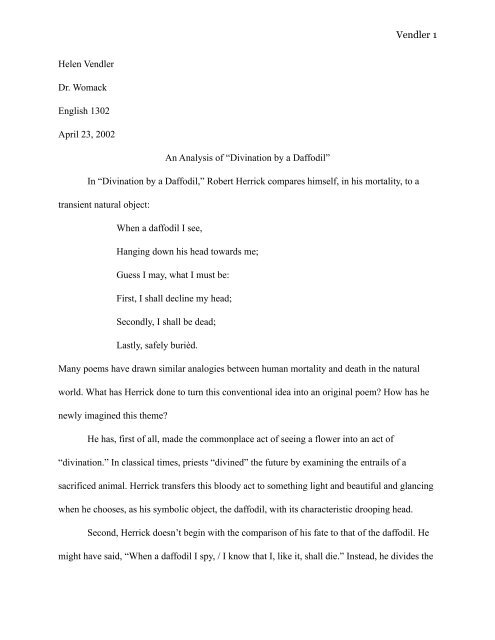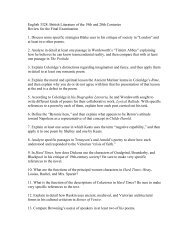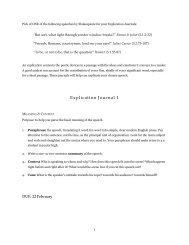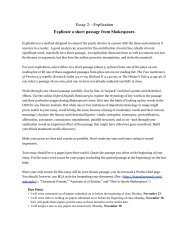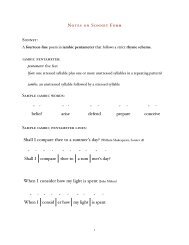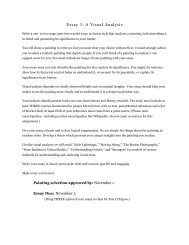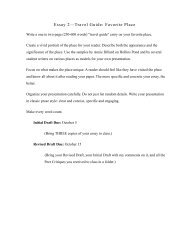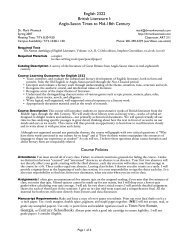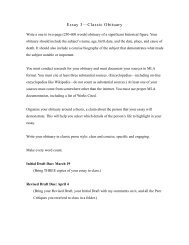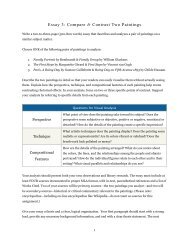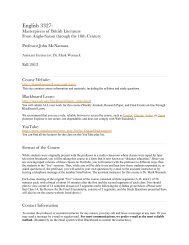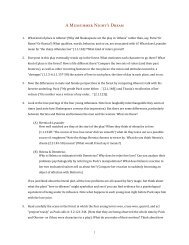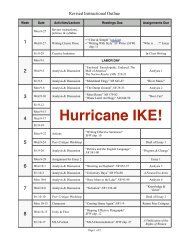Divination by a Daffodil - Dr. Mark Womack
Divination by a Daffodil - Dr. Mark Womack
Divination by a Daffodil - Dr. Mark Womack
You also want an ePaper? Increase the reach of your titles
YUMPU automatically turns print PDFs into web optimized ePapers that Google loves.
Vendler 1<br />
Helen Vendler<br />
<strong>Dr</strong>. <strong>Womack</strong><br />
English 1302<br />
April 23, 2002<br />
An Analysis of “<strong>Divination</strong> <strong>by</strong> a <strong>Daffodil</strong>”<br />
In “<strong>Divination</strong> <strong>by</strong> a <strong>Daffodil</strong>,” Robert Herrick compares himself, in his mortality, to a<br />
transient natural object:<br />
When a daffodil I see,<br />
Hanging down his head towards me;<br />
Guess I may, what I must be:<br />
First, I shall decline my head;<br />
Secondly, I shall be dead;<br />
Lastly, safely burièd.<br />
Many poems have drawn similar analogies between human mortality and death in the natural<br />
world. What has Herrick done to turn this conventional idea into an original poem? How has he<br />
newly imagined this theme?<br />
He has, first of all, made the commonplace act of seeing a flower into an act of<br />
“divination.” In classical times, priests “divined” the future <strong>by</strong> examining the entrails of a<br />
sacrificed animal. Herrick transfers this bloody act to something light and beautiful and glancing<br />
when he chooses, as his symbolic object, the daffodil, with its characteristic drooping head.<br />
Second, Herrick doesn’t begin with the comparison of his fate to that of the daffodil. He<br />
might have said, “When a daffodil I spy, / I know that I, like it, shall die.” Instead, he divides the
Vendler 2<br />
poem into two parts. He reserves the comparison to the second half of this single-sentence poem,<br />
leaving us to guess, as we read the first half, what he might be going to divine from his daffodil.<br />
When we note the general metrical scheme of the poem — “strong weak / strong weak /<br />
strong weak / strong” — we can see that the author wanted the first word of each line to bear<br />
emphasis. But the metrical emphasis is not crucial in the first half of the poem. The first three<br />
lines could equally well have read “weak strong / weak strong / weak strong / weak strong”:<br />
“A daffodil appears to me; / His head is hanging down, and we / Can guess from that what we<br />
must be.” The real purpose of the meter becomes clear when we arrive at the second half of the<br />
poem. The rhythm gives weight to “First . . . / Secondly . . . / Lastly,” which ring with inexorable<br />
emphasis in summoning up the last stages of life: illness, death, and burial. When we examine<br />
the rhyme scheme (aaabbb) we see that it possesses the same inevitability in the second half.<br />
Instead of the relatively uninteresting rhymes of the first half (see, me, be), we hear the deathknell<br />
of head, dead, burièd.<br />
Herrick has made his theme—man’s mortality—into a poem <strong>by</strong> imaging that one can<br />
divine one’s fate from a flower, <strong>by</strong> arranging a perfect spacial symmetry of three lines each to<br />
flower and man, and <strong>by</strong> letting us hear, after the inoffensive first three lines, the heavy tread of<br />
his own death announcement.


